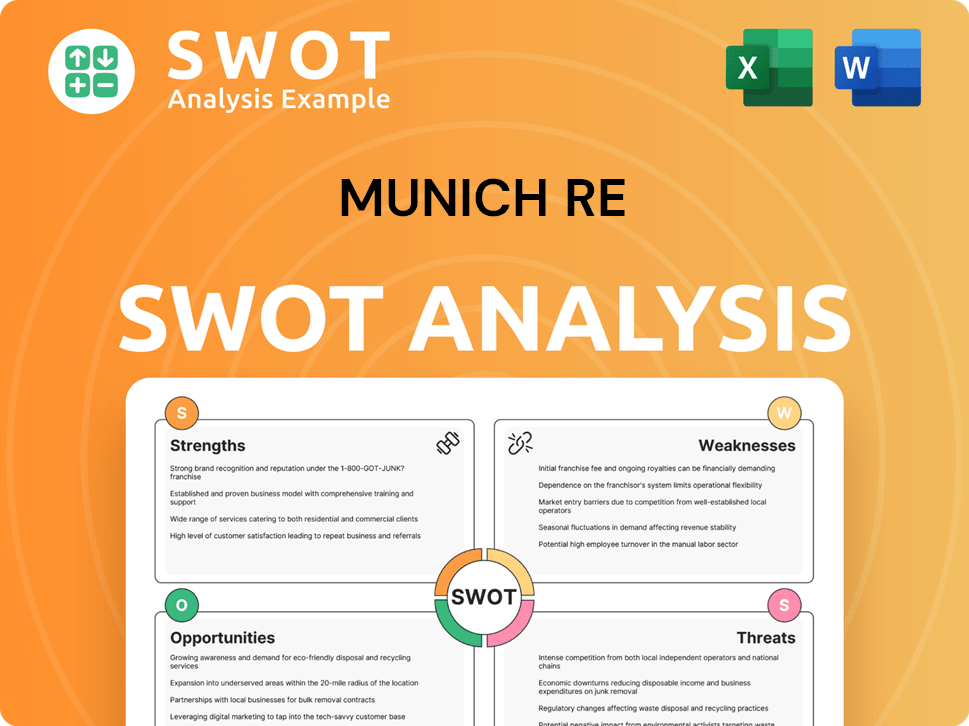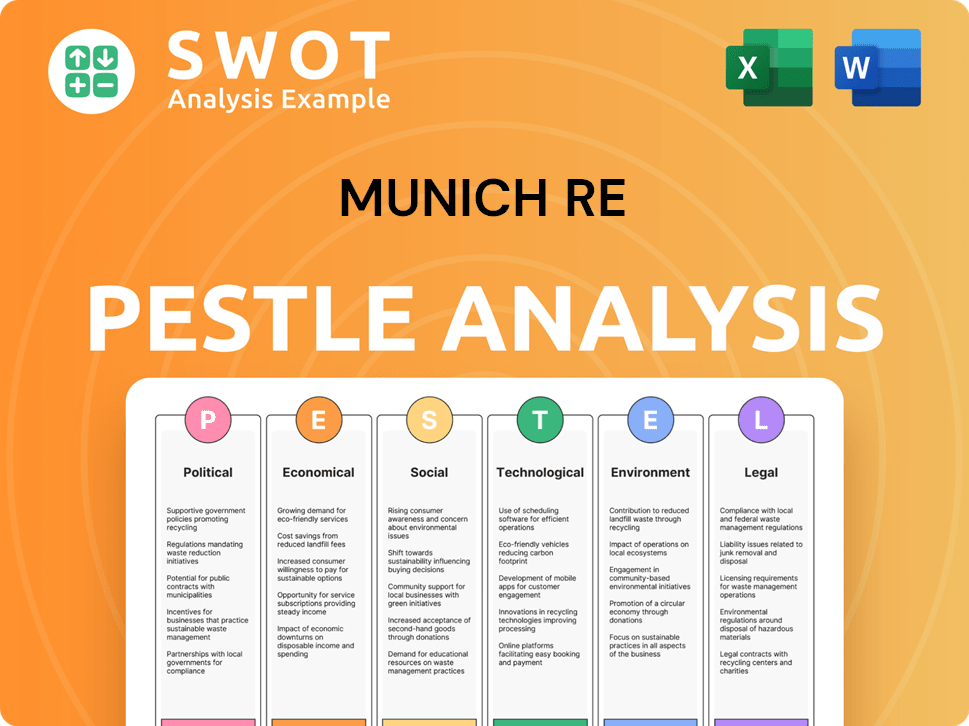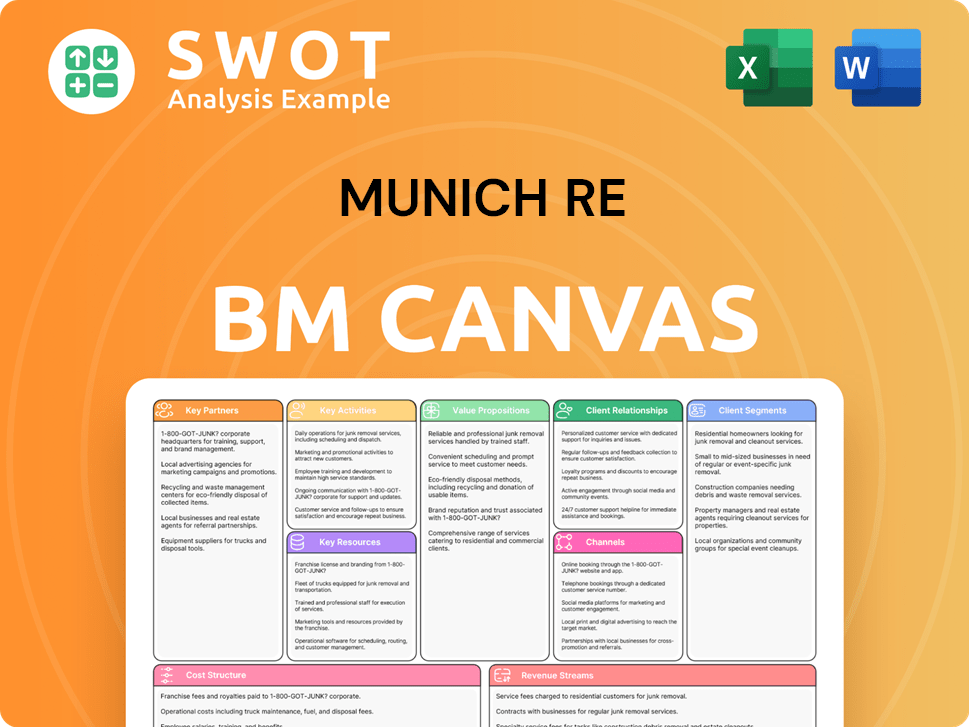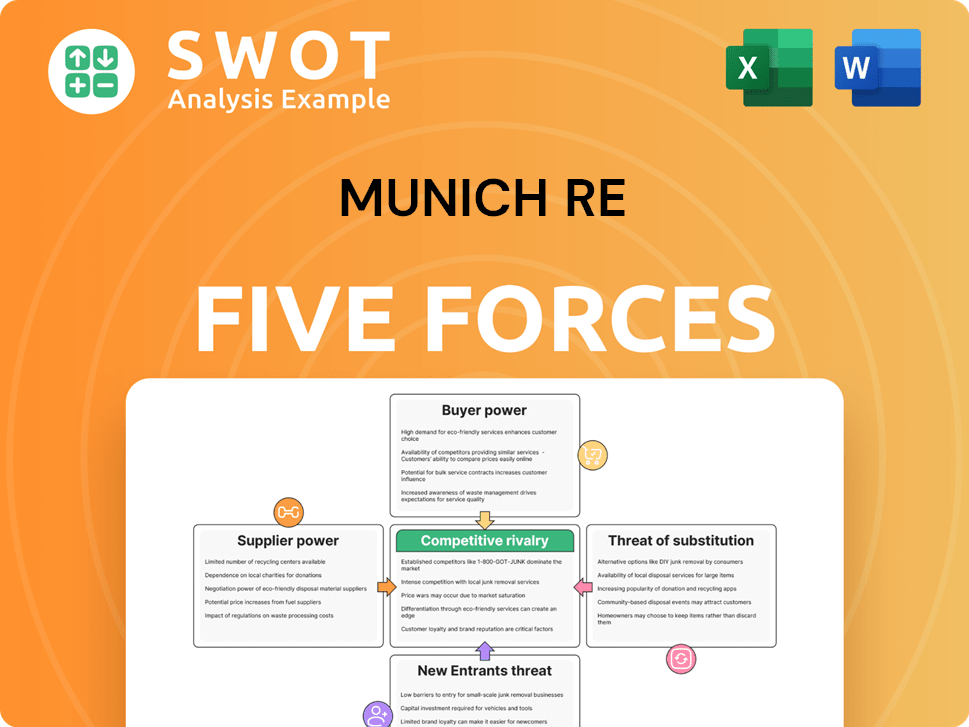Munich Re Bundle
How Does Munich Re Dominate the Global Insurance Market?
Founded in 1880, Munich Re has a storied history of safeguarding businesses and individuals from unforeseen risks. From weathering global catastrophes to adapting to evolving market demands, Munich Re's resilience is undeniable. In 2024 alone, it played a crucial role in mitigating the financial impact of natural disasters, highlighting its enduring significance in the Munich Re SWOT Analysis.

This article unveils the secrets behind Munich Re's success, exploring its sophisticated sales channels and innovative marketing tactics. We'll dissect how Munich Re strategically positions its brand in the competitive reinsurance market and examine the key campaigns that have fueled its impressive financial performance, including a remarkable €5.7 billion net result in 2024. Discover the intricacies of Munich Re's sales strategy and how it navigates the complexities of risk management, including its approach to climate risk and cyber insurance, ultimately revealing the core of its powerful business model.
How Does Munich Re Reach Its Customers?
The sales channels of Munich Re are multifaceted, reflecting its dual role as a reinsurer and a primary insurer. This approach ensures the company can reach a broad spectrum of clients and markets. The Munich Re sales strategy leverages a combination of direct sales, partnerships, and digital platforms to maximize its market penetration and revenue generation.
As a reinsurer, Munich Re primarily uses brokers, strategic partnerships, and direct collaboration with primary insurance companies. This business-to-business (B2B) model focuses on relationship management and providing tailored risk solutions. For its primary insurance arm, ERGO, Munich Re employs a mix of direct sales, digital platforms, and partnerships to reach individual and corporate clients. The Munich Re marketing strategy is designed to enhance customer experience and operational efficiency.
The evolution of these channels includes a strong emphasis on digital adoption and technological advancements. Munich Re has invested heavily in AI applications, identifying over 300 AI use cases to increase efficiency and maintain a competitive edge. This digital transformation extends to its primary insurance arm, ERGO, which is actively pursuing a leading role in digitalization through generative AI and chatbots to enhance customer experience.
Munich Re's reinsurance business primarily relies on brokers, strategic partnerships, and direct collaboration with primary insurance companies. This approach allows for the provision of bespoke risk solutions. The focus is on building strong relationships and understanding the specific needs of insurers, corporations, and public entities globally.
For its primary insurance arm, ERGO, Munich Re utilizes a mix of direct sales, digital platforms, and partnerships. This multi-channel approach enables ERGO to reach a wide range of customers, including individuals and businesses. Digital initiatives, such as AI-powered chatbots, are key to improving customer experience.
Munich Re is actively embracing digital transformation across its operations. This includes significant investments in AI applications and other advanced technologies. The goal is to enhance efficiency, improve customer service, and maintain a competitive edge in the market. Digitalization is a key component of the Munich Re business model.
Strategic partnerships and acquisitions play a crucial role in Munich Re's growth strategy. These collaborations help expand market share and provide access to new markets. Recent examples include the renewal of partnerships with companies like Hanersun and acquisitions like Storebrand Helseforsikring AS and ADB Gjensidige, as well as the planned acquisition of Next Insurance.
Munich Re's sales and marketing strategies are designed to capitalize on opportunities in the reinsurance market and primary insurance sectors. The company focuses on innovation, digital transformation, and strategic partnerships to drive growth and enhance customer value. These initiatives are crucial for maintaining its position in the global insurance market.
- Digitalization: Implementing AI and other technologies to improve efficiency and customer experience.
- Strategic Partnerships: Collaborating with key players to expand market reach and access new opportunities.
- Acquisitions: Expanding its primary insurance offerings through strategic acquisitions.
- Risk Management: Leveraging its expertise in risk management to provide tailored solutions.
In 2024, Munich Re's collateralized reinsurance sidecar structures, such as Eden Re and Leo Re, grew to $650 million, reflecting the company's reliance on partnerships with institutional investors. ERGO expanded its international business through acquisitions, including Storebrand Helseforsikring AS and ADB Gjensidige. The acquisition of Next Insurance is expected to further expand its primary insurance offerings. For more insights into the competitive landscape, consider reading about the Competitors Landscape of Munich Re.
Munich Re SWOT Analysis
- Complete SWOT Breakdown
- Fully Customizable
- Editable in Excel & Word
- Professional Formatting
- Investor-Ready Format

What Marketing Tactics Does Munich Re Use?
The marketing tactics of Munich Re are multifaceted, designed to enhance its position in the reinsurance market and drive sales. The company employs a blend of digital strategies and traditional methods to reach its target audience and communicate its value proposition. These tactics are continuously evolving to address emerging risks and leverage technological advancements.
Munich Re's approach includes a strong emphasis on digital transformation, data-driven marketing, and customer experience. They consistently invest in technologies like AI and machine learning to improve underwriting and enhance client offerings. This comprehensive strategy supports the company's business model and its ability to compete effectively.
The company's marketing efforts are also shaped by its commitment to thought leadership and industry presence. They actively participate in conferences and publish insights on critical topics, demonstrating their expertise in risk management and insurance.
Munich Re heavily invests in digital technologies to improve its services. This includes the use of AI, machine learning, and analytics to enhance underwriting processes and client offerings. The launch of the GenAI CoPilot on its REALYTIX ZERO platform in May 2024 is a prime example of this focus.
The company emphasizes data-driven marketing, customer segmentation, and personalization to improve customer experience. This includes using chatbots and virtual assistants, particularly within its ERGO segment. This approach helps to refine its risk management strategies.
Munich Re allocated approximately $1.2 billion to ICT spending in 2023. A significant portion of this was dedicated to software, network and communications, and hardware. These investments support its technology platforms and analytics tools.
Munich Re uses traditional media and events to maintain its industry presence and thought leadership. They actively participate in and partner with industry conferences, such as the International Conference on Inclusive Insurance 2024. This helps in its sales strategy.
The company's marketing mix has evolved to address emerging risks like cyber threats and climate change. They provide insights and publications on these topics. The 'Tech Trend Radar 2024' report highlights key insurance technology trends.
Munich Re focuses on enhancing customer experience through technological advancements. This includes the use of chatbots and virtual assistants. These efforts support its business model and customer relationship management.
Munich Re's marketing strategy is designed to build brand awareness, generate leads, and drive sales. This involves a combination of digital and traditional methods, with a strong emphasis on innovation and customer engagement. The company's approach to the reinsurance market is data-driven and forward-thinking.
- Digital Marketing: Utilizes AI, machine learning, and analytics to enhance underwriting and client offerings.
- Thought Leadership: Actively participates in industry conferences and publishes reports on emerging risks.
- Customer-Centric Approach: Focuses on improving customer experience through technology like chatbots.
- Investment in Technology: Allocates significant resources to ICT, including software and hardware.
Munich Re PESTLE Analysis
- Covers All 6 PESTLE Categories
- No Research Needed – Save Hours of Work
- Built by Experts, Trusted by Consultants
- Instant Download, Ready to Use
- 100% Editable, Fully Customizable

How Is Munich Re Positioned in the Market?
Munich Re's brand positioning is carefully designed to convey professionalism, trustworthiness, and innovation within the global reinsurance and insurance market. The company strategically positions itself as a committed partner and a forward-thinking innovator, aiming to shape a more resilient future through advanced insights and rapid innovation. This core message is consistently communicated across all channels, emphasizing its expertise in risk analysis, assessment, and diversification to create lasting value for stakeholders.
The company's visual identity, including its logo, colors, and image style, is guided by a clear brand strategy to ensure consistent and impactful communication worldwide. This approach allows for flexibility while maintaining a strong connection between independent brands, like ERGO Group, and the overarching Munich Re brand. This cohesive branding supports its Munich Re sales strategy and overall market presence.
Through its focus on innovation, particularly in areas like cyber insurance and climate change solutions, Munich Re effectively appeals to its target audience. The company is actively building one of the largest cyber insurance portfolios among European reinsurers, complementing its emphasis on technology and data analytics. This strategic focus underscores its commitment to addressing evolving risks and offering cutting-edge solutions, which supports its Munich Re marketing strategy.
Munich Re is heavily investing in innovation, especially in cyber insurance and climate change solutions. This focus helps the company stay ahead of evolving risks and offer cutting-edge solutions to its clients. This is a key element of its Munich Re business model.
The global cyber insurance market was valued at approximately US$15.3 billion in 2024. Experts at Munich Re anticipate this market to more than double by 2030, with an average annual growth rate exceeding 10%. This expansion is a significant part of their strategy.
Munich Re's strong financial health, highlighted by a solvency ratio of 287% at the end of 2024, well above its optimal range of 175%-220%, reinforces its brand promise of resilience and stability. This financial stability reassures clients and investors alike.
The company maintains a consistent brand message across all channels, emphasizing its expertise in risk analysis and diversification. This consistency helps build trust and reinforces Munich Re's position in the reinsurance market.
Munich Re's brand is built on several key elements that contribute to its strong market position.
- Professionalism: Munich Re is known for its professional approach and expertise in the insurance sector.
- Trustworthiness: The company's long history and financial stability help build trust among clients and partners.
- Innovation: Munich Re continually invests in new technologies and solutions to address evolving risks.
- Commitment: Munich Re is committed to being a reliable partner for its clients, helping them navigate complex risks.
For more information on the company's financial performance and shareholder information, you can read more about the Owners & Shareholders of Munich Re.
Munich Re Business Model Canvas
- Complete 9-Block Business Model Canvas
- Effortlessly Communicate Your Business Strategy
- Investor-Ready BMC Format
- 100% Editable and Customizable
- Clear and Structured Layout

What Are Munich Re’s Most Notable Campaigns?
The sales and marketing strategies of Munich Re are centered around strategic initiatives rather than traditional advertising campaigns. The company's approach focuses on long-term objectives, such as enhanced profitability, growth, and return on investment, rather than short-term promotional activities. This strategic focus is a key element of its business model.
A significant aspect of Munich Re's strategy involves leveraging digital transformation and integrating AI to improve its offerings. This strategy is evident in the launch of new products and partnerships aimed at enhancing client offerings and driving automation. These initiatives position Munich Re as a leader in the reinsurance market, using advanced technology for risk management and product development.
Strategic partnerships and acquisitions are crucial for Munich Re's growth. These moves demonstrate its commitment to expanding its primary insurance footprint, adapting to market changes, and strengthening its international presence. These actions reflect Munich Re's adaptability and financial strength within the reinsurance market.
Launched in 2021, the 'Ambition 2025' program has been a cornerstone of Munich Re's sales strategy. This initiative aimed to boost profitability and growth. The company has consistently exceeded its profit targets, reporting a net result of €5.7 billion in 2024, surpassing its initial target of €5 billion.
Munich Re actively integrates digital solutions and AI to refine its services. The introduction of the GenAI CoPilot on the REALYTIX ZERO platform in May 2024 exemplifies this. These advancements enhance client offerings and automate processes, providing a competitive edge in risk management.
Strategic alliances and acquisitions are vital for Munich Re's expansion. The acquisition of the remaining 50% of Storebrand Helseforsikring AS in Norway in 2024 and the agreement to acquire ADB Gjensidige in the Baltics are key examples. These actions strengthen its primary insurance business through ERGO.
Munich Re is expanding its presence in the insurtech space, as demonstrated by the acquisition of Next Insurance. This move, valued at $2.6 billion, highlights the company's commitment to innovation and growth within the primary insurance sector. This is a key part of their Growth Strategy of Munich Re.
Munich Re Porter's Five Forces Analysis
- Covers All 5 Competitive Forces in Detail
- Structured for Consultants, Students, and Founders
- 100% Editable in Microsoft Word & Excel
- Instant Digital Download – Use Immediately
- Compatible with Mac & PC – Fully Unlocked

Related Blogs
- What are Mission Vision & Core Values of Munich Re Company?
- What is Competitive Landscape of Munich Re Company?
- What is Growth Strategy and Future Prospects of Munich Re Company?
- How Does Munich Re Company Work?
- What is Brief History of Munich Re Company?
- Who Owns Munich Re Company?
- What is Customer Demographics and Target Market of Munich Re Company?
Disclaimer
All information, articles, and product details provided on this website are for general informational and educational purposes only. We do not claim any ownership over, nor do we intend to infringe upon, any trademarks, copyrights, logos, brand names, or other intellectual property mentioned or depicted on this site. Such intellectual property remains the property of its respective owners, and any references here are made solely for identification or informational purposes, without implying any affiliation, endorsement, or partnership.
We make no representations or warranties, express or implied, regarding the accuracy, completeness, or suitability of any content or products presented. Nothing on this website should be construed as legal, tax, investment, financial, medical, or other professional advice. In addition, no part of this site—including articles or product references—constitutes a solicitation, recommendation, endorsement, advertisement, or offer to buy or sell any securities, franchises, or other financial instruments, particularly in jurisdictions where such activity would be unlawful.
All content is of a general nature and may not address the specific circumstances of any individual or entity. It is not a substitute for professional advice or services. Any actions you take based on the information provided here are strictly at your own risk. You accept full responsibility for any decisions or outcomes arising from your use of this website and agree to release us from any liability in connection with your use of, or reliance upon, the content or products found herein.